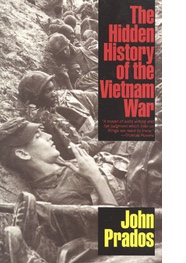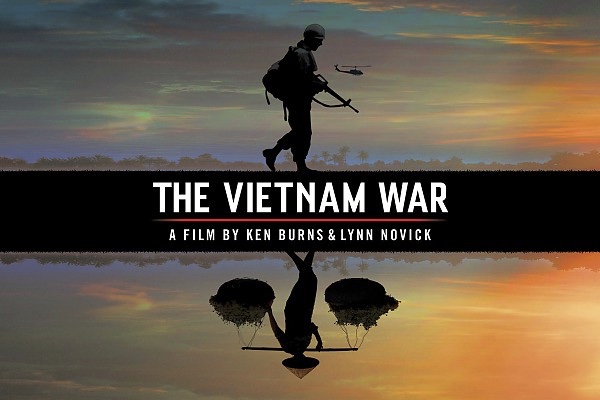Vietnam in the Rearview Mirror: Why Victory Was an Illusion
Related Link HNN’s Full Coverage of “The Vietnam War” documentary by Ken Burns and Lynn Novick
Hugh Heffner passed away last week. Last week also saw broadcast of the final episode of the Ken Burns and Lynn Novick mammoth documentary film “The Vietnam War.” As the auteur of Playboy, Heffner exerted enormous influence on the American—perhaps even international— social and cultural psyche. That influence is something auteurs Burns and Novick probably aspire to. But “The Vietnam War” won’t get them there. The filmmakers’ steady refusal to make anything out of their story elements, and their latter-day hinted-at but never explicitly stated “honor the troops” undertone, make this documentary a platform for the neo-orthodox culture war players who want to win a war in the judgment of history that the nation experienced as a defeat in fact. Looking at Vietnam in the rearview mirror—which Burns and Novick failed to do—reveals why the neo-orthodox who pine for the lost victory are simply misguided.
 First
off, getting into the Vietnam War wasn’t simply a matter of matter
of smart officials making reasonable choices in the face of a Cold
War crisis. Approaching Vietnam was a matter of passing many
thresholds,
each one of them also an opportunity to avoid war. American
presidents involved the nation in the conflict primarily to pursue
Cold War aims, but without understanding the Vietnamese revolution.
They did this in the face of an American tradition of
anti-colonialism, and specifically in an era when waves of
decolonization were sweeping across the globe. The best and brightest
national security team simply assumed they knew better. But it was
the United States vainly trying to withstand the floodtide of
history, not the Viet Minh or our later North Vietnamese adversaries.
First
off, getting into the Vietnam War wasn’t simply a matter of matter
of smart officials making reasonable choices in the face of a Cold
War crisis. Approaching Vietnam was a matter of passing many
thresholds,
each one of them also an opportunity to avoid war. American
presidents involved the nation in the conflict primarily to pursue
Cold War aims, but without understanding the Vietnamese revolution.
They did this in the face of an American tradition of
anti-colonialism, and specifically in an era when waves of
decolonization were sweeping across the globe. The best and brightest
national security team simply assumed they knew better. But it was
the United States vainly trying to withstand the floodtide of
history, not the Viet Minh or our later North Vietnamese adversaries.
Next is the matter of strategy. A winning strategy had to employ what was actually there, what resources our South Vietnamese ally possessed, hampered by the political manipulations, military coups, and institutional frailties of the Saigon government. The strategy needed to utilize the military and intelligence forces and methods of the time—and since Washington had trouble defining the problem, that meant a process of triangulation had to occur to improve focus, then match resources to the challenge. That automatically inserted a temporal dimension. Time was required to focus better, to derive a solution, to activate the forces necessary to strive for victory. But rising political opposition limited time. The moment was foreseeable when internal domestic dissent would necessitate a retraction of effort. Moreover the triangulation that had to be made between problem and strategy had to occur against an evolving threat. Hanoi had a say, too.
Plus, both the definition of threat and the winning strategy had to be found within the confines of an apparatus that was generating false information. All the data was subjective. The number of miles of cleared roads, percentage of villages loyal to Saigon (what was “loyalty,” by the way, how do you measure it?), strength of the Liberation Front’s infrastructure, the thousands of men under arms, variations in the enemy’s projected “order of battle,” the body count, tons of bombs dropped. What mattered? What did not? We never knew. We still don’t know today. Victory was an illusion.
The antiwar movement was not just a hodgepodge of people scared for their own skins. To be sure, here were young men motivated by facing the draft, but the basis for the war came up short. There was no real declaration of war, official arguments sounded hollow, our South Vietnamese allies openly corrupt—all factors further complicated by the subjective data. Both government lying and security crackdowns contributed, making the war reach into the lives of ordinary Americans. Those tactics were another deliberate choice, and did not come from random selection.
Speaking of tactics, the military’s standard procedures were hardly calculated to win hearts and minds—the asserted purpose of our strategy. “Search and Destroy” burned villages and made refugees of peasants. “Body Count” made civilians (peasants) targets to add to the supposed index of success. “Free Fire Zones” put the meaning into phrases like “kill anything that moves.” Then there was “Harassment and Interdiction” —randomized destruction on the off chance it might affect some enemy purpose. And don’t forget the bombing. Three times as many bombs were loosed over South Vietnam as over the north. All that is before you get to “Phoenix,” a deliberate war against the adversary’s political (read “civilian”) apparat, run subjectively like everything else, with the potential to strike down anyone—your neighbor, your debtor, your critic. Successive directives issued to improve legal modalities in the Phoenix system had little apparent impact.
When the North Vietnamese and Liberation Front suffered major losses in the successive waves of the Tet Offensive, they withdrew into base areas where the United States could hardly touch them. When Washington was forced to begin withdrawing from South Vietnam, the enemy could bide its time until the right moment. The adversary shifted to conventional force tactics just as the Americans perfected pacification. Now facing a powerful antiwar opposition, the Nixon administration’s efforts to escalate the war by striking into Cambodia and Laos inevitably generated further restrictions on Washington’s use of force. Hanoi failed when it attempted to try for a decision in 1972, but the blunting of the Easter Offensive by U.S. airpower backing the South Vietnamese army was considerably less than the success claimed in Saigon. Portions of the southern state were lopped off, never to be regained. The consequences for the South Vietnamese economy of the departure of half a million American GIs could not be avoided, and oil price hikes after 1972 eroded another slice of Saigon’s economic potential. The war ended in 1975 with the North Vietnamese marching into Saigon, not the other way around. Neo-orthodox commentators routinely distort or deny various parts of this story. Victory is an illusion.
